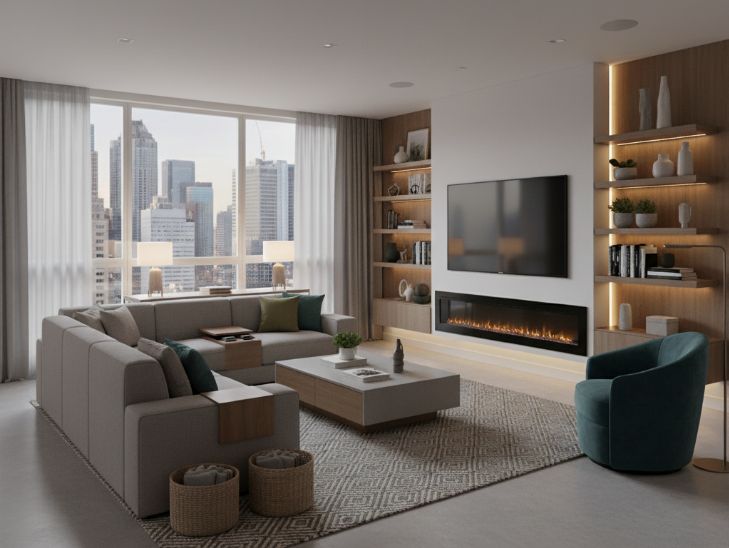The modern style is characterized by simplicity, functionality and clean lines that convey order and sophistication. Inspired by 20th century architecture and design, it seeks to combine aesthetics and practicality, using neutral colors, natural materials and minimalist furniture.
Adopting this style in your home not only brings elegance, but also creates open, bright and harmonious environments, ideal for modern living.
Let’s take a look at the origins, the keys and how to apply this style to different spaces.
Table of Contents
- Origin and Philosophy of the Modern Style
- Defining Features of the Modern Style
- Furnishings and decorative objects: Selection with Intent
- Application by Environments (practical ideas)
- Variations and Fusions within the Modern Style
- Common Mistakes and How to Avoid Them
- Fundamental Elements of Modern Style
Origin and Philosophy of the Modern Style
Before going into more, let’s say, technical matters, it is worth stopping for a moment to know where this style comes from and the principles on which it is based.
Historical roots and evolution (from modernism to the current modern)
The modern style began in the late 19th century, influenced by the transformations of the Industrial Revolution, which brought mass production and new materials such as steel, glass and concrete.
These advances allowed for bolder and more functional forms, in contrast to the ornate decoration of the Victorian and Art Deco styles. Movements such as art nouveau broke with previous styles, integrating art and architecture, but it was the Bauhaus movement, founded in 1919 by Walter Gropius, that consolidated the modern style, combining art, technology and architecture.

The Bauhaus advocated simplicity, pure geometry, functionality and the use of industrial materials. This approach focused on the functionality of objects.
Over time, the Bauhaus and its ideas influenced globally, adapting to the needs of the 20th century, especially with movements such as the International Style, which focused on new technology and materials.
Architects such as Mies van der Rohe and Le Corbusier created open spaces and clean lines, contrasting with previous ornamental styles.
Today, the modern style is still current, adapted to technological advances and materials, while maintaining its principles of simplicity, functionality and honest use of materials.
Philosophical principles: form follows function.
The philosophy of modern style is centered on the principle that “form follows function,” advocated by architects such as Louis Sullivan and Le Corbusier. This concept holds that the design of an object or space should be based on its practical purpose, not on aesthetic considerations unrelated to its use.
Functionality implies not only efficiency, but also a rational design that solves problems in an efficient and accessible manner. Furniture, for example, is intended to serve a clear purpose, without unnecessary elements. In terms of space planning, priority is given to circulation and the logical organization of areas.
The modern style also promotes an economy of means, seeking solutions with the minimum of materials without compromising quality. In addition, it values material honesty, presenting materials such as steel, concrete, glass and wood as they are, without hiding their properties.
In short, the philosophical principles of modern style focus on simplicity, functionality and transparency of materials, eliminating any excess that does not contribute to performance or utility.
Defining Features of the Modern Style
Let’s now look in detail at the key features of modern style such as clean lines, focus on functionality or the materials most commonly used.
Geometry and functionality: simplicity with intention.
Modern style is characterized by a focus on clean lines and geometric shapes, seeking simplicity and order. It avoids the use of ornamental details, opting for straight lines, flat surfaces and geometric volumes that create balance and visual harmony. Geometry has both aesthetic and practical value, optimizing circulation and use of space, and allowing for better organization.

This principle is applied in architecture and furnishings, with smooth walls, simple furniture and large windows that maximize natural light. Geometric shapes contribute to an orderly and relaxing environment.
In terms of functionality and spatial planning, priority is given to the efficient use of space, avoiding clutter and unnecessary barriers. Fluid zoning is key, with open circulation that facilitates interaction between areas.
Elements such as open living rooms and kitchens and modular furniture that adapts to needs optimize the use of space. The design also favors free circulation between areas, improving accessibility without sacrificing style or comfort.
Contemporary materials and their aesthetic reading
Materials in modern design serve both a practical and an aesthetic function. Industrial materials such as steel, glass, concrete and light woods are preferred, used honestly, without hiding them with unnecessary layers of paint.
Polished concrete provides solidity without embellishment and is combined with softer materials such as marble, glass and textiles such as wool and linen.
Steel and aluminum in the furnishings offer strength and contribute to the minimalist aesthetic, while glass maximizes natural light, enhancing spaciousness and connection to the outdoors.
Light woods, such as oak, add warmth to the environment, contrasting with cold materials such as concrete and metal.
Base palette: warm and cool neutrals complemented with accents.
The use of color in the modern style is essential to create a serene and orderly environment. The base palette consists mainly of neutral tones, such as off-white, soft grays, beige and black in small details.
These colors provide a balanced background, visually expanding the spaces and creating a bright and calm atmosphere. White reflects light, making small spaces feel larger, while gray and beige bring understated elegance and serenity.
To prevent spaces from becoming monotonous, color accents are incorporated in elements such as cushions, rugs or vases. Shades such as mustard, petrol blue and olive green add depth and vibrancy without disrupting the harmony of the design. These color accents should be controlled, complementing the neutral palette without overloading the space.
This balanced approach to the use of color creates a visually relaxing and inviting environment, ideal for comfort and contemplation.
Subtle textures and finishes
Although the modern style uses cold materials such as steel and concrete, textures play a key role in softening these surfaces and bringing warmth. Natural materials and soft textures are incorporated, such as short pile carpets, which not only add comfort and warmth, but also improve acoustics in open spaces.
Natural fabrics such as linen, cotton and wool in cushions, curtains or upholstery provide a sense of comfort and fit well with the minimalist aesthetic.
Light woods, such as oak or maple, are used in flooring and furniture, offering a warm texture that contrasts with cold materials such as metal or concrete. These woods have matte finishes that highlight their natural grain, while polished stone or marble accents add subtle texture, adding elegance to the space.
In terms of finishes, the modern style favors matte finishes, which offer a clean and refined look, softening the light and creating relaxing environments. They are used in furniture and surfaces such as tables, shelves and wooden floors.
Glossy finishes are used sparingly for details such as door handles, chair frames and decorative objects, providing sophistication and contrast without overloading the environment.
The balance between matte and gloss is essential to maintain visual harmony and fluidity in the space.
Furnishings and decorative objects: Selection with Intent
Having defined the fundamentals, materials and base colors of the modern style, it is now time to define how we apply them in the form of furniture, decorative objects, textiles and lamps.
Iconic furniture and functional pieces
Modern furniture stands out for its simplicity and functionality, with pieces that fulfill a practical function and have a timeless and ergonomic design. Elements such as the modular sofa, tables with simple legs and chairs with clean lines are essential in this style.
Modular sofas are a key example, with a versatile design that allows you to change their configuration according to the needs of the space. Their minimalist structure emphasizes comfort without unnecessary embellishment. Materials, such as linen or leather, follow the principles of functionality and simplicity without sacrificing comfort.
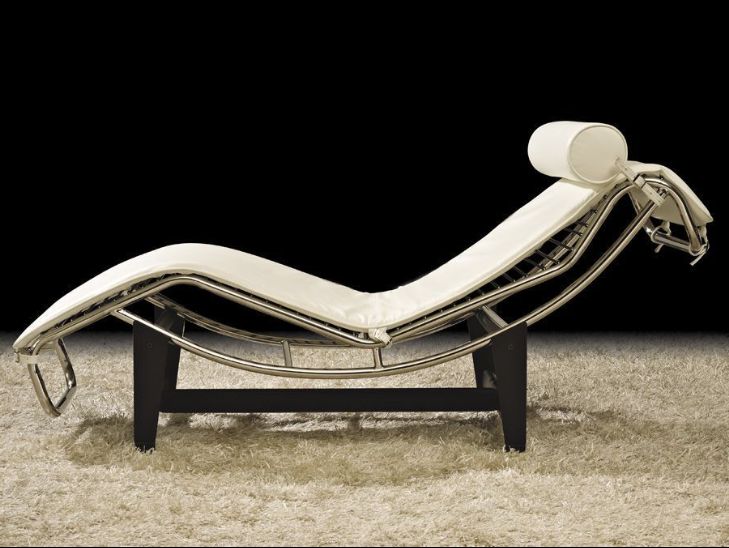
Tables with simple legs and geometric shapes, made of light wood or matte metal, create visual coherence in the space. Ergonomics is essential in chairs and other furniture, prioritizing comfort without compromising style.
Modern furniture also encourages the use of multifunctional furniture, such as sofas that convert into beds, tables with storage or bookshelves that serve as desks, optimizing the use of space and efficiency.
Lighting as interior architecture
Lighting not only serves a practical function, but is also integrated into interior architecture as a key design element. Modern style lamps are not only sources of light, but contribute to the character and aesthetics of the space.
Recessed luminaires, common in ceilings and walls, provide soft, even illumination without disrupting the clean aesthetics of the room. Dimmable spotlights allow the intensity of light to be adjusted according to activity or time of day.
In addition, floor or table lamps, with sculptural or minimalist designs, not only illuminate, but add visual interest.
Indirect lighting, reflected on walls or ceilings, creates a warm and relaxing atmosphere, ideal for living rooms and bedrooms. In the kitchen, lighting integrated into cabinets or under shelves expands the space without resorting to exposed bulbs.
In this way, lighting enhances both functionality and design, creating specific environments such as efficient work areas or cozy living rooms.
Recommended products

In Stock, delivery in 15-20 days
20.49 £
Dipley 6W Portable LED Table Lamp with USB Rechargeable Battery
View product

In Stock, delivery in 15-20 days
49.99 £
Reflect Textile Pendant Lamp
View product
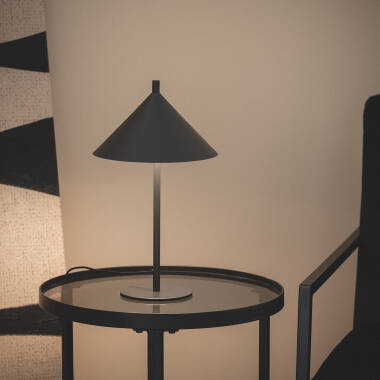
In Stock, delivery in 15-20 days
14.19 £
Carmale Metal Table Lamp
View product
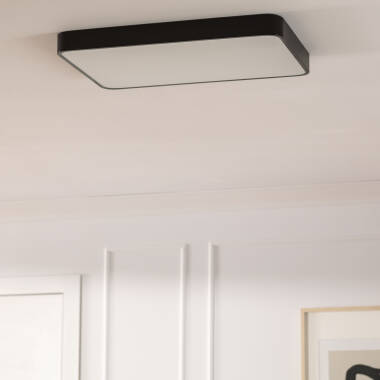
In Stock, delivery in 15-20 days
41.99 £
40W Hidria Selectable CCT Rectangular Metal LED Surface Panel 600x400 mm
View product
Textiles and accessories: balance between function and warmth.
Although modern style promotes simplicity, textiles and accessories are key to adding warmth and comfort without overloading the space. These elements should complement the minimalist design while maintaining functionality and aesthetics.
Cushions, rugs and curtains are chosen for their ability to provide comfort and visual balance. Cushions, in neutral colors such as beige, gray or off-white, are made of natural materials such as linen or cotton, which balance softness with minimalist aesthetics.
Rugs, in short pile or natural textures, soften spaces and add warmth to concrete or wood floors, as well as help define zones in open spaces such as living or dining rooms.
Curtains, made of light fabrics such as linen or cotton in neutral tones, let in natural light without sacrificing privacy, and fit perfectly with the modern style.
Accessories are limited but important, with minimalist graphic art, simple line sculptures and discreet vases, which complement the space without competing with it, always with an aesthetic or functional purpose.
Application by Environments (practical ideas)
Below you can find some ideas to apply in a simple way the principles of modern style to different spaces in the home.
Living room: flexible and fluid social area
The living room is the heart of the modern home, a space that should be flexible and fluid, adapting to social and family needs without losing the simplicity that characterizes the modern style. The goal is to create a multifunctional area, ideal for relaxing, entertaining guests or family activities, all within a spacious and welcoming environment.
The furniture should be modular to adapt to different configurations. For example, a modular sofa can be rearranged according to the number of people or the layout of the space. Coffee tables are simple and straight-lined, with materials such as light wood, metal or glass, keeping the aesthetic clean. Integrated storage is also key in the modern living room. Floating shelves or built-in storage furniture allow you to keep the space tidy without sacrificing style.

Circulation is an essential aspect of the modern living room. Avoid overloading the space with large or unnecessary furniture, looking for a free flow between areas. Open areas allow the living room to connect with other areas of the house, such as the dining room or kitchen, creating an open and social atmosphere. Soft lighting through floor lamps, recessed or dimmable, contributes to create a warm and cozy atmosphere without interrupting the aesthetics of the space.
Kitchen: modernity is also practical
The modern kitchen, more than just a space for preparing food, is a multifunctional area and a social place par excellence. Modern design seeks a functional distribution, where each element has its clear purpose and circulation is fluid. It is common to find L-shaped kitchens or kitchens with a central island, which not only provides additional space for cooking, but also for interacting while preparing meals.
The furnishings are characterized by smooth fronts and the absence of ornamentation. Integrated appliances, such as dishwashers, ovens and microwaves, are hidden behind panels that match the furniture design, creating a continuous, clean surface. Work surfaces are practical and easy to clean, with materials such as granite, corian or stainless steel, matching both functionality and minimalist aesthetics.
Smart storage is key in the modern kitchen. Cabinets with handle-free opening systems, sliding shelves and vertical storage solutions maximize space without cluttering the environment. In terms of lighting, recessed ceiling lights or spotlights directed on work surfaces are preferred, ensuring good visibility without interrupting the clean design.
Bedroom: minimalist and warm refuge
The bedroom in the modern style is a space dedicated to rest, so its design should reflect calm and simplicity. The minimalist atmosphere is key: functional furniture and minimal decoration contribute to creating a relaxing atmosphere.
The bed is usually the center of the bedroom, with a discreet headboard that can be made of light wood, metal or even upholstered in neutral tones. The furniture is reduced to the essentials: a bedside table, a built-in or plain closet and sometimes a small wooden chair or bench. The use of soft, natural textiles, such as cotton sheets or wool blankets, adds comfort and warmth to the space.
Walls are usually in neutral tones, such as off-white or soft gray, creating a bright and calm environment. The lighting is soft and warm, with table or floor lamps of simple design, allowing the intensity of light to be adjusted as needed. Decorative details, such as a minimalist painting or a discreet sculpture, add character without cluttering the space.
Bathrooms: home spa with visual cleanliness
The modern bathroom seeks a clean and relaxing aesthetic, similar to a home spa. Instead of ornate tiles or traditional finishes, continuous materials such as marble, polished concrete or natural stone are used to create a sense of fluidity and connection between the different elements of the bathroom.
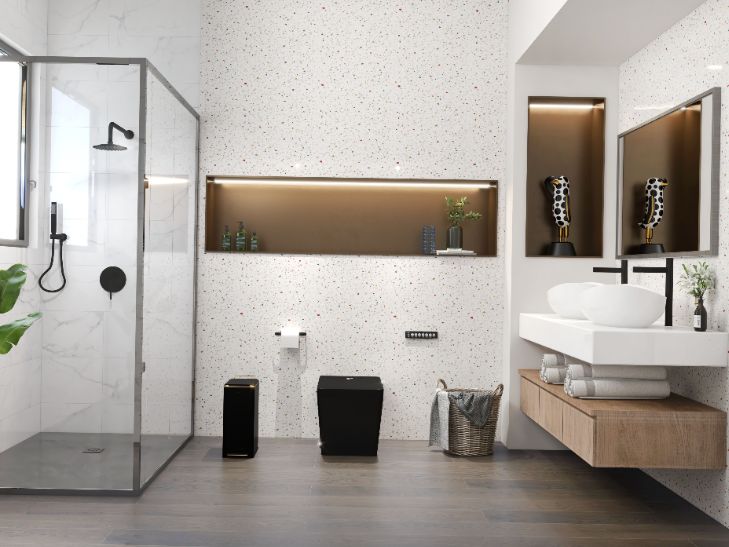
Shower enclosures are an essential feature of the modern bathroom, generally without profiling, offering a cleaner, uncluttered aesthetic. Minimalist faucets, with straight lines and matte or chrome finishes, complement the design without drawing attention to themselves. The furniture is functional and simple lines, such as sinks integrated into stone or wood countertops, and storage hidden under the sinks or in floating shelves.
Lighting in the bathroom is key to creating a relaxing atmosphere. Recessed, dimmable lights or mirrors with integrated LED lighting provide a soft, pleasant light, ideal for a quiet bathroom.
Small homes: maximizing the perception of space
In small homes, modern design plays a key role in maximizing the perception of space. The key is to optimize the use of space through multifunctional furniture and efficient storage. Light colors, such as white, gray and beige, are used on walls, furniture and floors to create a sense of spaciousness. In addition, reflective surfaces, such as glass or steel, help reflect natural light and visually expand the space.
Furniture should be compact and fit the dimensions of the home. For example, a modular sofa that can convert into a bed, an extendable dining table or a desk that doubles as a dining table. Vertical storage is a key strategy to take advantage of wall and ceiling space, using high shelves or built-in cabinets.
Family homes vs. young professionals
Modern style adapts to the needs of each type of home. In family homes, the design seeks to create functional and comfortable spaces, where each family member has his or her place. Open areas and multifunctional furniture are essential to facilitate circulation and social interaction.
For young professionals, the design can be more minimalist and focused on work areas within the home, such as integrated desks or storage solutions that do not take up too much space. Materials and colors are kept sober, but the focus is on creating an environment that inspires productivity without sacrificing comfort and aesthetics.
Variations and Fusions within the Modern Style
As with all great decorating styles variations and fusions with other styles are no exception. Some of the most common are:
Warm Modern
Warm modern is a variation of the modern style that softens the coldness of minimalism. It uses natural materials and earthy colors to create a cozy atmosphere. Instead of just steel and glass, it incorporates dark woods, leather and natural fabrics such as terracotta, mustard and weathered wood. Wool rugs and linen cushions add comfort and warmth.
The use of textures is key, combining polished concrete with warm woods to balance modern and cozy. This approach creates a simple, functional and enveloping home.
Modern minimalist
Minimalist modern is a more reductionist version of modern style, focusing on the principle of “less is more.” The design is stripped of everything unnecessary, with geometric shapes, neutral colors and empty spaces that add no functional or aesthetic value.
Each piece of furniture is selected for its quality and simplicity, with clean-lined furniture made from materials such as light wood, stainless steel and glass. The use of neutral colors maintains visual serenity, and decoration is limited to the essentials.
Negative space is key, with plenty of empty space allowing each element to stand out individually, creating an uncluttered, calm and functional environment.
Industrialized modern
Modern industrial combines raw and robust elements typical of industrial aesthetics, such as concrete, steel and exposed pipes, but balanced with refined finishes and soft materials to avoid an overly harsh environment.
This style utilizes the straight lines and geometry of modern design, incorporating details such as exposed brick, large windows and metal structures. Polished finishes in metals and reclaimed wood soften the ambiance, bringing rustic character to the modern space.
Lighting is key, with industrial-style spotlights, iron lamps and exposed bulbs, creating a unique, urban atmosphere.
Nordic / Scandinavian Modern
Nordic or Scandinavian modern is characterized by its focus on light and functionality. This style is perfect for those looking for bright, cozy and simple spaces, but without losing comfort.
Nordic interiors are generally very bright, using light colors such as white, soft gray or light wood. Natural surfaces, such as light pine or oak, bring a sense of warmth to the spaces. Furniture, with simple and functional lines, is often multifunctional, such as benches that serve as storage or extendable coffee tables.
Natural light is a key feature of the Nordic style, and interiors are designed to make the most of the available light. Large windows, neutral colors and bright finishes allow the room to feel open, bright and full of life.
Common Mistakes and How to Avoid Them
Modern style is, by its very nature, minimalist and refined, but that doesn’t mean it’s always easy to achieve. Often, designers and homeowners make mistakes that can ruin the harmony and functionality of spaces. Here are some of the most common mistakes when implementing modern style and how to avoid them.
- Cold spaces that lack personality: Extreme minimalism can make the environment lack warmth. Warm textures and accessories that give personality without overloading the space should be incorporated.
- Overload of design pieces: Using too many design pieces can overload the room. It is important to choose functional and balanced objects.
- Poor scale and proportion: Disproportionate furniture can unbalance the space. Furniture should be in keeping with the size of the room.
- Insufficient lighting: Lack of adequate lighting makes the space gloomy. Incorporating efficient natural and artificial light is key.
- Cheap materials: Using low-quality materials breaks the feeling of elegance. It is essential to choose authentic and quality materials.
Fundamental Elements of Modern Style
The modern style is distinguished by its focus on simplicity and functionality, with clean lines and the use of materials such as steel, glass and wood. The neutral color palette and the efficient organization of space are essential, always seeking adaptability and comfort.
Modular furniture and integrated technology allow for the creation of practical and visually pleasing environments, combining the functional with the cozy.

